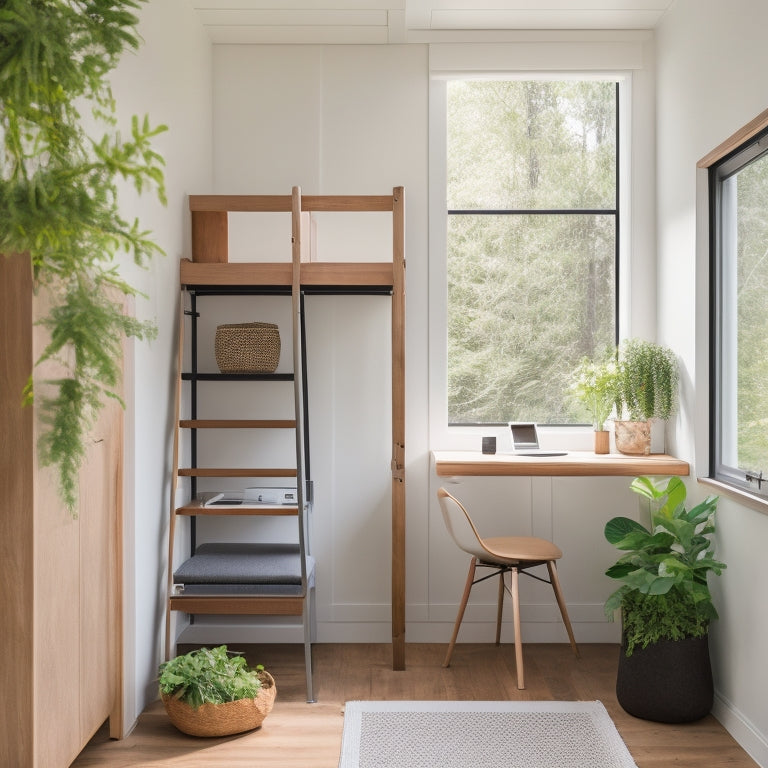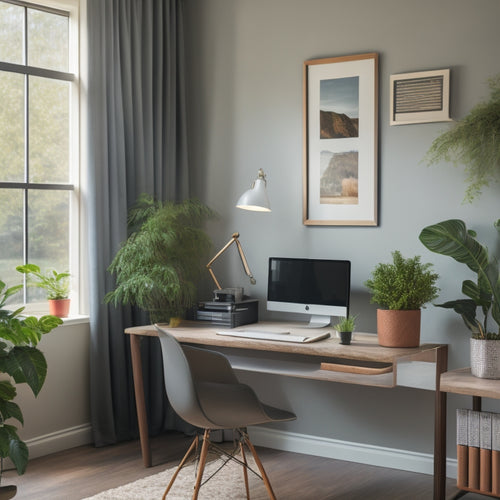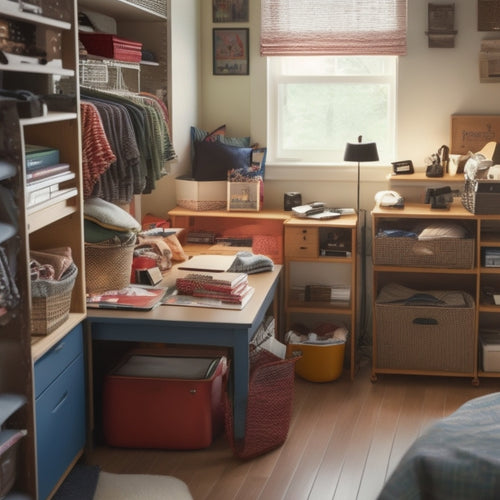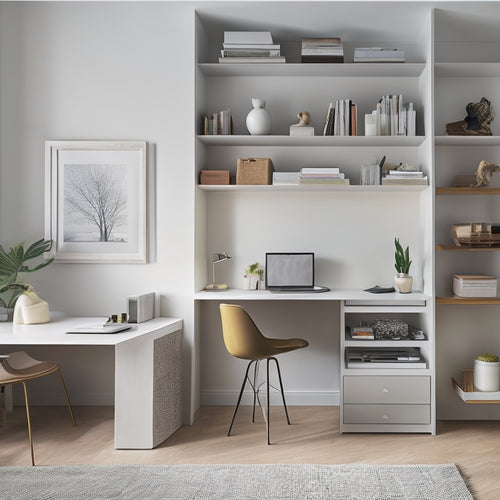
Maximizing Storage in Tiny Homes: Essential Decluttering Tips
Share
You're about to discover the secret to maximizing storage in your tiny home, where every square inch counts, and clutter has no place to hide. Start by decluttering and prioritizing multi-functional items that serve more than one purpose. Optimize your vertical storage space with shelves, hooks, and storage units. Designate a home for each item, and edit your belongings to keep only what's essential. Utilize hidden storage areas, like under-bed storage and secret compartments. Finally, implement a maintenance routine to keep your space organized and clutter-free. You're just getting started on the path to a more streamlined, functional living space.
Key Takeaways
• Assess and clear out clutter to allocate space efficiently and create a fresh, functional living area in tiny homes.
• Prioritize multi-functional items and furniture that serve multiple purposes to reduce clutter and optimize storage.
• Designate a home for each belonging to maintain organization and implement color coding and labeling for easy identification.
• Utilize hidden storage areas such as under-bed storage and secret compartments to maximize storage capacity in tiny homes.
• Edit and curate belongings by purging unwanted items, keeping memories, and grouping similar objects for efficient organization.
Start With a Clean Slate
Clearing out clutter and unnecessary items is the initial crucial step in maximizing storage in your tiny home, as it allows you to assess what you really need and where to allocate space efficiently. This process gives you a fresh beginning, a chance to start anew and create a space that truly reflects your needs and lifestyle. Think of it as an empty canvas, waiting for you to add the essentials that will make your tiny home functional and comfortable.
As you sort through your belongings, be ruthless – if you don't need it, don't keep it. This is especially important in a tiny home, where every square inch counts. Consider donating, selling, or recycling items that are still in good condition, and discard anything that's broken or no longer useful.
Prioritize Multi-Functional Items
When furnishing your tiny home, prioritize multi-functional items that serve more than one purpose, allowing you to conserve valuable space and reduce clutter. This approach will help you make the most of your limited square footage.
For instance, consider a sofa bed that doubles as a comfortable seating area and a cozy sleeping space. This single piece of furniture serves two purposes, freeing up room for other essentials.
Similarly, look for space-saving desks with built-in storage or a dining table with shelves underneath. These furniture hacks will help you optimize your space and keep clutter at bay.
Optimize Vertical Storage Space
Make the most of your tiny home's vertical space by installing shelves, hooks, and storage units that reach up to the ceiling, effectively doubling or tripling your storage capacity. This will allow you to store more items without taking up valuable floor space.
Consider using shelf dividers to separate and organize items on each shelf, keeping similar items together and making them easy to find.
Ceiling hooks are another great way to optimize your vertical storage space. Hang bikes, baskets, or even pots and pans from the ceiling to keep them out of the way but still accessible.
When choosing storage units, look for ones with adjustable shelves and compartments to customize your storage to your specific needs. Don't forget about the space above your closet or kitchen cabinets - install shelves or storage units here to maximize every inch of your tiny home.
Designate a Home for Everything
When you designate a home for everything in your tiny home, you'll be able to find what you need quickly and easily.
This means assigning a specific spot for each item, so it's always in the same place.
Assign a Spot
Designate a specific place for each item in your tiny home, ensuring that everything has a designated 'home' where it can be easily found and stored away. This simple habit will revolutionize your daily routine and help maintain a sense of organization.
For instance, assign a spot for your morning essentials, like your coffee mug and favorite book, near the kitchen area. This way, you'll develop a consistent morning routine, and your personal boundaries will be respected as you enjoy your quiet time.
Label and Sign
By labeling and signing each designated spot, you'll create a visual system that reinforces your organizational habits and helps maintain a clutter-free environment. This step is essential in maximizing storage in your tiny home.
Labels and signs serve as constant reminders of where items belong, making it easier to put things back in their assigned spot.
Consider implementing color coding to categorize similar items or areas of your home. For instance, use blue labels for cleaning supplies and green for kitchen utensils. This visual cue will help you quickly identify where items belong.
Additionally, incorporate personalized markings that resonate with you, such as using stickers or doodles that reflect your personality. This will make the labeling process more enjoyable and increase your chances of sticking to your organizational system.
Edit and Curate Belongings
As you work to maximize storage in your tiny home, it's essential that you take a hard look at what you're storing in the first place.
You'll need to decide what's truly important to keep and what can be let go of, a process that requires you to be honest with yourself about your needs and priorities.
Purge Unwanted Items
Sort through your belongings and separate them into three piles: keep, donate/sell, and discard, to address the challenging task of purging unwanted items that are taking up valuable space in your tiny home. This important step can be overwhelming, but it's vital to maximizing storage.
Emotional attachment to certain items can make it difficult to let go, but remember that holding onto clutter can lead to decision fatigue, making it harder to make decisions about what to keep and what to get rid of.
To make the process easier, follow these tips:
-
Be ruthless: If you haven't used it in the past year, it's likely you won't miss it.
-
Let go of duplicates: If you have multiple items that serve the same purpose, keep only your favorite or the one in the best condition.
-
Consider the 80/20 rule: 80% of the time, you likely only use 20% of your belongings. Identify the items that fall into this category and prioritize keeping those.
- Keep the memories, not the item: If you're holding onto an item due to sentimental value, consider taking a photo of it and letting it go. This way, you'll preserve the memory without the physical clutter.
Group Similar Objects
Now that you've purged your unwanted items, it's time to organize what's left by grouping similar objects together, which will help you visualize your remaining belongings and make intentional decisions about what to keep and how to store it. This process is called object categorization, and it's essential for maximizing storage in your tiny home. By grouping similar objects, you'll be able to see what you have, what you need, and what you can let go of.
Start by categorizing your items into tasks or activities, such as cooking, cleaning, or entertainment. This task segmentation will help you identify what items belong together and how they can be stored efficiently.
For example, group all your kitchen utensils together, and then separate them into subcategories like baking, cooking, or serving. This will help you determine what items to keep and how to store them in a way that makes sense for your tiny home.
Utilize Hidden Storage Areas
What secret spaces in your tiny home can be repurposed to stash your belongings, freeing up valuable floor space and reducing clutter? Think beyond traditional storage solutions and get creative! You can transform overlooked areas into hidden storage gems.
Here are some ideas to get you started:
-
Under-bed storage: Use bed risers or storage bins to stash out-of-season clothing, linens, or luggage.
-
Secret compartments: Convert a hollowed-out book or a decorative box into a hidden storage space for valuable items like jewelry or important documents.
-
Hidden shelves: Install sliding shelves behind a mirror or a piece of art to store books, decorative items, or kitchen utensils.
- Window seat storage: Build a window seat with a hinged top to store throw pillows, blankets, or even a few favorite books.
Implement a Maintenance Routine
To prevent clutter from building up again, you'll need to establish a regular maintenance routine that keeps your tiny home organized and tidy. This means creating daily checklists to make sure you're staying on top of clutter.
Set aside a few minutes each day to quickly pick up items that are out of place, wipe down surfaces, and make your bed. These small tasks will add up and make a big difference in the long run.
In addition to daily maintenance, consider implementing a seasonal refresh. This could mean deep cleaning your tiny home, reorganizing your storage spaces, or donating items that are no longer needed. By doing a seasonal refresh, you'll be able to identify areas where clutter tends to accumulate and make adjustments to prevent it from building up again.
Frequently Asked Questions
How Do I Decide What to Keep and What to Get Rid Of?
You're worried that getting rid of stuff means erasing painful memories? Don't worry, you're not erasing the past, just the physical reminders. Ask yourself: does it align with your personal values, or is it holding you back?
Can I Still Have Sentimental Items in a Tiny Home?
You can still keep sentimental items in a tiny home, but be intentional; consider digitizing memories to preserve your Digital Legacy, and acknowledge the Emotional Attachment driving your decisions, then curate a few truly meaningful keepsakes.
What if I Need to Store Bulky or Oversized Items?
You're stuck between a rock and a hard place, literally, with bulky items. Consider outdoor containers or vertical shelving to maximize space; these solutions will help you store oversized items without suffocating your tiny home.
How Often Should I Declutter and Reorganize My Tiny Home?
You should declutter and reorganize your tiny home regularly, incorporating seasonal rotations every 3-4 months and daily habits like tidying up for 10 minutes each morning to maintain a clutter-free space.
Are There Any Specific Storage Solutions for Tiny Home Kitchens?
You'll love these space-saving solutions for your tiny home kitchen! Install kitchen shelves to maximize vertical storage, and consider corner carousels to access hidden items with ease, keeping your kitchen organized and clutter-free.
Related Posts
-

Master Your Space With Digital Decluttering Tools
You're tired of feeling overwhelmed by digital clutter, wasting time searching for lost files, and struggling to focu...
-

Why College Students Need Smart Storage Systems
As you navigate the challenges of college life, you'll quickly realize that a smart storage system is essential to tr...
-

7 Essential Strategies for More Storage Space
Take back control of your space by implementing these 7 essential strategies for more storage space. Start by maximiz...


